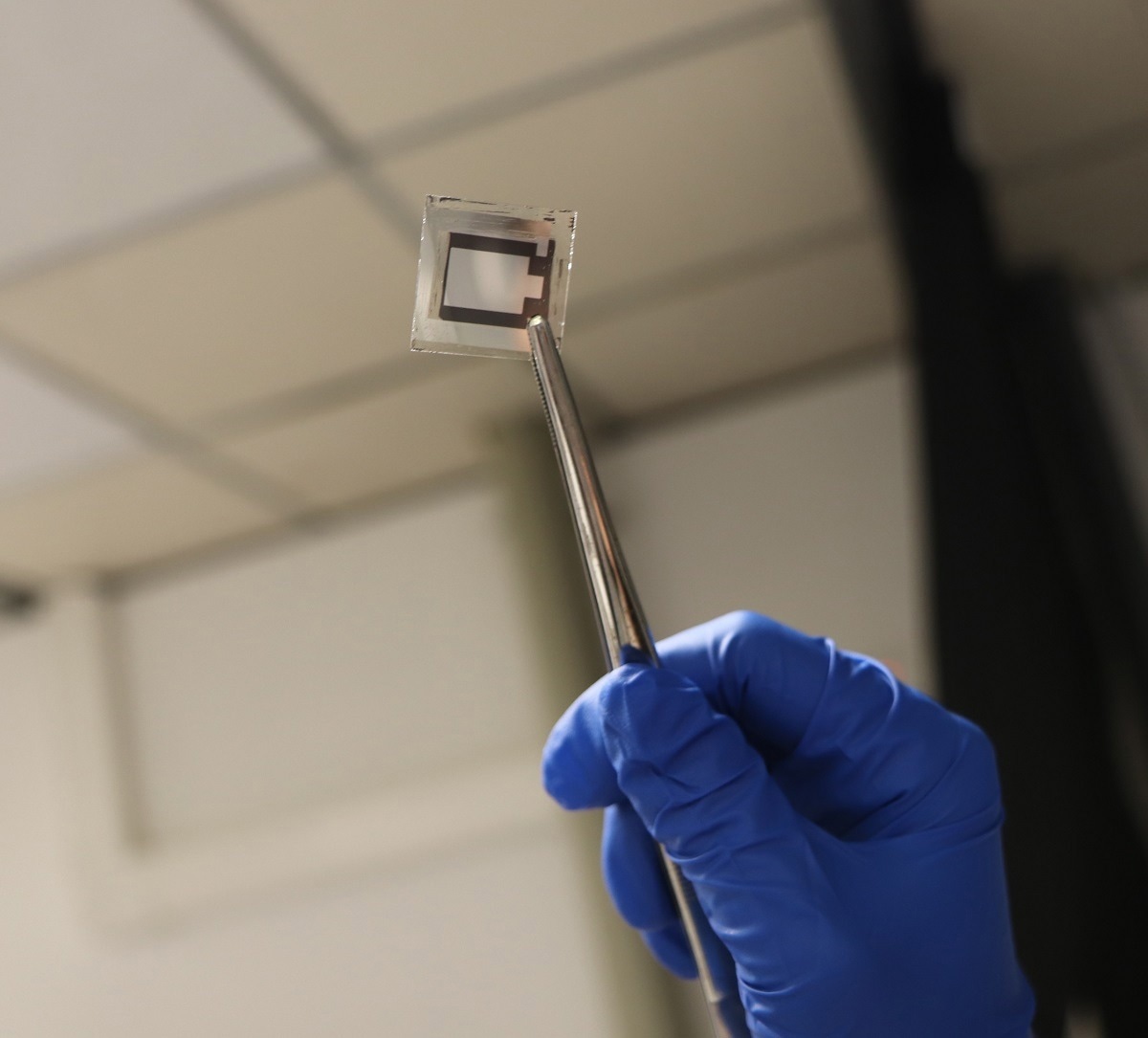Perovskite solar cells (PVSCs) are an enticing alternative to conventional silicon-based solar cells due to their greater power efficiency and low cost. However, achieving long-term stability has been one of the most difficult challenges in their development.

Photo of a 1 cm2 perovskite solar cell with additive. Image Credit: City University of Hong Kong
A City University of Hong Kong (CityU) research team recently made a breakthrough by inventing a unique multifunctional and non-volatile additive that can improve the efficiency and stability of perovskite solar cells by modifying perovskite film development. This straightforward and practical technique has the potential to significantly accelerate the commercialization of PVSCs.
This type of multifunctional additive can be generally used to make different perovskite compositions for fabricating highly efficient and stable perovskite solar cells. The high-quality perovskite films will enable the upscaling of large-area solar panels.
Alex Jen Kwan-yue, Professor and Director, Hong Kong Institute for Clean Energy, City University of Hong Kong
Alex Jen Kwan-yue is also the Lee Shau Kee Chair Professor of Materials Science. Professor Alex Jen Kwan-yue guided the research.
PVSCs have gotten a lot of attention because of their remarkable solar power conversion efficiency (PCE). PVSCs have the potential to be used in building-integrated photovoltaics (BIPV), wearable devices, and solar farm applications since perovskites may be deposited from solutions onto manufacturing surfaces.
However, the severe energy loss linked with defects embedded at perovskite interfaces and grain boundaries continues to have an impact on efficiency and stability. As a result, the inherent quality of perovskite film is crucial in determining PVSC efficiency and stability.
Even though many earlier studies have concentrated on increasing film morphology and quality with volatile additives, these compounds tend to escape from the film after annealing, leaving a void at the perovskite–substrate interface.
To address these challenges, CityU researchers devised a simple but successful technique for controlling perovskite film development to improve film quality. They discovered that adding a multifunctional molecule [4-guanidinobenzoic acid hydrochloride, (GBAC)] to the perovskite precursor results in the formation of a hydrogen-bond-bridged intermediate phase that modulates crystallization to produce high-quality perovskite films with large perovskite crystal grains and coherent grain growth from the bottom to the surface of the film.
Due to its non-volatility, this molecule can also serve as an effective defect passivation linker (a method to lower the defect density of perovskite film) in annealed perovskite film, resulting in dramatically reduced non-radiative recombination loss and enhanced film quality.
Their research demonstrated that by injecting GBAC, the defect density of perovskite films can be greatly lowered. The power conversion efficiency of inverted (p-i-n) perovskite solar cells based on modified perovskites was increased to 24.8% (24.5% approved by the Japan Electrical Safety & Environment Technology Laboratories), one of the highest reported in the literature.
Furthermore, the device’s overall energy loss was reduced to 0.36 eV, one of the lowest energy losses among PVSC devices with high power conversion efficiency.
Furthermore, the unencapsulated devices have improved thermal stability over 1,000 hours of continuous heating at 65 ± 5 °C in a nitrogen-filled glovebox while retaining 98% of the original efficiency.
The researchers demonstrated the strategy’s wide applicability for various perovskite compositions and large-area devices. For example, in the experiment, a bigger area device (1 cm2) generated a high PCE of 22.7% using this technique, demonstrating significant promise for building scalable, highly efficient PVSCs.
This work provides a clear path to achieving optimized perovskite film quality to facilitate the development of highly efficient and stable perovskite solar cells and their upscaling for practical applications.
Alex Jen Kwan-yue, Professor and Director, Hong Kong Institute for Clean Energy, City University of Hong Kong
The team hopes to extend the molecular structures and optimize the device structure in the future using compositional and interfacial engineering. They will also concentrate on the production of large-area devices.
The study was funded by CityU, the Innovation and Technology Commission, the Research Grants Council, the Green Tech Fund of the Environment and Ecology Bureau in Hong Kong, the Guangdong Major Project of Basic and Applied Basic Research, and the Guangdong-Hong Kong-Macao Joint Laboratory of Optoelectronic and Magnetic Functional Materials.
Journal Reference
Li, F., et al. (2023). Hydrogen-bond-bridged intermediate for perovskite solar cells with enhanced efficiency and stability. Nature Photonics. doi.org/10.1038/s41566-023-01180-6.